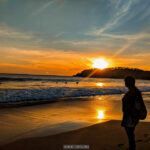
The origin of the Naga tribes: Khezakeno, Nagaland
Around 60 km from the state capital of Kohima in the Phek district of Nagaland lies the legendary Naga village of Khezakeno. This is supposed to be the place where all the Naga tribes actually originated from. The village of Khezakeno is located at an altitude of around 5,545 feet above sea-level.
Khezakeno

To reach this legendary village of Khezakeno travellers have very limited transportation options. Hiring a private taxi from Kohima is the best option since the shared jeeps that ply to this village are not very reliable as very few people travel to this village. The return journey from Khezakeno might be a problem if one opts to travel to this village by a shared jeep. A private taxi can be hired from anywhere in Kohima the best option is to hire one from the guest house or from the Nagaland tourism department. A private taxi ride is costly but totally worth every penny for this tribal village.
The road leading to the village of Khezakeno beyond the check post at Mao is very bad. There is loose mud and pools of water along the road; which make the 60 km drive take around three hours one way and a real adventure with the car bouncing all over the place. It is advisable to start your road trip from Kohima as early as possible.
The villagers from Khezakeno belong to the Chskhesang tribe and Koza is the surname of every family in this village. The Khezakeno village has endless stretches of paddy fields and a thick dense forest which is rich in natural vegetation. Farming is their main source of income and their principal occupation, too. The village houses in Khezakeno are on a slope and nearly all the houses are still in their traditional make.

All of them are made of bamboo walls, mud flooring and inside the houses there is nothing more than a wooden bench to sit on and a handful of vessels. All the houses in Khezakeno have a fire place which is used for cooking and to keep warm during the winter months.
It is common to see older women spinning yarn on their traditional weaving machines which are very unique and made out of wood and have a wheel at one end and a long wooden slender plain attached to the wheel. The yarn is made by spinning the wheel, processing it into thin string. The older men can be seen working in their house compound and drying cardamom which is grown in the forest nearby.
Lower down in the central area of the village are three stone slabs placed on the side, tribals from Khezakeno say that these stone slabs were places by their ancestors hundreds of years ago. The former ruler’s house is locked up and has dead animal’s skulls and horns along with wooden carvings in the shape of human faces carved on the front wall of the house.

About 15 meters from the king’s house is a rectangular wall constructed by the villagers which houses a long stone slab which is around 7.5 feet high and also has a bed of stones. The bed of stones was a miracle place and villagers claim that anything that was offered to the spirits was doubled. This place does not look like much but it is here at this very spot where the three sons of the ruler had a heated argument and the youngest son burnt down the place.
After the fight, the three decided to take the people who were under them and go their separate ways and this gave rise to the first three tribes. The Chakhesang, Angami and Sumi are the core tribes and the remaining tribes were all formed later on from these three tribes.
The path leading to the paddy fields has five stone slabs placed adjacent to each other and villagers claim that this used to be a single living rock which used to grow each year towards the heavens and when the three brothers split the Naga tribe into three the spirit gods got angry and killed the living rock and split it into five stones.
While visiting Khezakeno it is a must to have someone as a guide who can explain all the historical symbolism that is present in the village or this village will be just another Naga tribal village. Khezakeno is a village which is very rich in culture and heritage. It is a must-visit for anyone who comes to Nagaland.
For a similar experience, >>Click here












Nagaland is a place I can on,y travel through these blogs. It’s just somewhere I know I’ll never end up reaching anytime soon.
I have been meaning to write something like this on my site and you have given me an idea. Cheers.